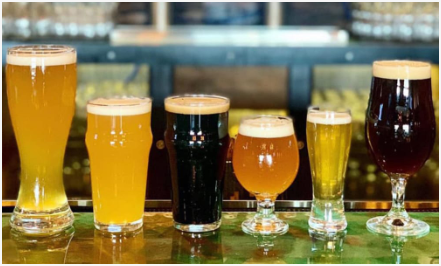No matter the job, sometimes you know: “I want a beer.”
Beer’s not therapeutic or medicinal, of course (although maybe there’s some study that Ivermectin taken daily with a case of beer reduces awareness of strokes).
I’m no expert (you’re welcome), and, besides, some beer “reviews” tend to float through readers’ brains like bubbles from the bottom of a lager anyway. But there’s a place for commenting on what’s available for curious connoisseurs or foamheads who shop where beer’s displayed between Slim Jims and live bait. So consider this a quick, light-hearted (not Lite-hearted) report from a few brewery visits.

Reportedly, 63% of adults drink alcohol and 42% of them prefer beer, so there’s a market, and the market for really good beer has expanded far beyond First World trust-fund dudes with beards named Biff. It’s now affordable, with greater variety, and local! Peoria is lucky to have several breweries offering dozens of flavors on tap.
First a little background:
The word “beer” has roots far beyond Homer Simpson and the less-animated Brett Kavanaugh — to Old English, German and possibly Latin (though snooty Romans reportedly considered beer “barbaric.” In fact, Roman Emperor Julian, a classic one-percenter, supposedly said wine had an odor of a nectar but beer smelled like a goat, which if uttered today might be an invitation to an ambulance ride).
Anyway, there are so many stories associated with the advent of brewing it’s a wonder the History Channel hasn’t spun off some Ancient Astronaut series theorizing extraterrestrial brewers. Evidence of early beers have been found in Egypt (using honey), Ethiopia (wheat), China (millet), Peru (corn), and India (rice). Beer apparently was consumed throughout the Mideast and also the western hemisphere, from the Incas to the Pueblos.
It was practical, too.
Before sanitation worldwide, drinking water could get contaminated, so maybe beer was initially, accidentally “discovered” by thirsty people who, afterward, burped, relieved themselves, and eventually, intentionally produced beer in consistent ways. Also, nomads realized wild grain stored in damp caves became moist and fermented. Almost anything containing sugar can ferment, and beer and bread could be stored and saved as food staples, decreasing the need for daily hunting, gathering, etc. That let our ancestors relax a bit, creating early leisure and more time to think, invent and create (and, OK, procreate).
Some sources claim that in ancient Egypt and Iran, workers reportedly were “paid” with beer, confirming that for centuries beer has been a reward as well as rehydration for workers perhaps needing amusement after a long, hard day’s exploitation.
Today, the Dark Age of Prohibition has vanished into the overflowing urinals of the Past. But modern society “developed” a contemporary equivalent to Prohibition’s extremely low-alcohol near-beer: Alcohol-free disasterpieces like Budweiser Zero.
Fortunately, more sensible or ambitious craft brewers might have been nudged along to deliver delicious alternatives to the “great taste, less filling” myth — or the Generics that giant multinational corporations produce like so many Beer Nuts (made in Illinois!).
I’m told there are differences between microbreweries, craft breweries, brewpubs, etc. beyond Manufacturers’ Suggested Retail Price. Microbreweries make less than 15,000 barrels of beer annually and sell at least three-fourths of their beer elsewhere; craft breweries generally opt for quality over quantity (like pop/soul/ R&B rocker Teddy Swims!); brewpubs offer food and beer, selling at least 25% of their beer on-site.
Regional breweries produce up to 6 million barrels a year, and the Big Boys dominate with volume, but they sometimes substitute rice or corn for hops to cut costs, like the hedge funds eviscerating newspapers.
A Sampling Snapshot
Bearded Owl Brewing, 112 State St.
Low Key Basic has a mild bitterness, like Bernie Sanders after Hillary’s 2016 nomination. Described as a “hazy” India pale ale, its sweet aftertaste features hops with an air of “Norway spruce,” but the toasty, restful result won’t make you feel like a lumberjack.
Shaky Knees, fermented with sourdough culture, is a strawberry/vanilla potion akin to some sort of Fizzie blast with a nice bite. Despite the key ingredients, it’s less fruity than full-bodied and floral.
Industry Brewing Co., 8012 N. Hale Ave.
Sunday’s Sidework is a robust wheat, dry, spry, even grassy, it goes well with the joint’s “amber ambience” of Tidy Warehouse, with walls and fixtures adorned with corrugated metal and rough-hewn wood planks that give it a Destination setting.
2021 4 Roses Imperial Stout is a cherry vanilla concoction that might seem like a failed soda-fountain experiment, but it has a terrific tension, with a weighty heft yet a “Dramamine Dreamcicle” effect that clears your head and resists the strong stout dizziness that can befall Libation Loons.

Obed & Isaac’s Microbrewery & Eatery, 321 NE Madison Ave.
Peoria Skyline, sipped in the stellar environment that used to be a church, and then a venue for weddings and music (I saw Johnny Winter there in 1989), the crisp delight has a citrus seasoning that’s slightly surprising but not overpowering.
Strawberry Blonde’s heady fragrance makes a bright and wistful favorite: a real memory maker.
Full disclosure: I also had a Ditzy Blonde (rim shot!) with my brunch dish of an Andouille sausage “Slinger,” and the smooth, savory beverage was as pleasant companion as a good-humored teammate from a losing sports team.
Rhodell Brewery, 100 Walnut St.
Mid West Wheat avoids the safe “amber waves of grain” imagery with a soft bite without the sense of drinking with training wheels.
Blueberry Cream Ale is more creamy than fruity, although the berry flavor is present. Swishing it around the mouth is as refreshing as homemade ice cream on a blistering summer afternoon.







